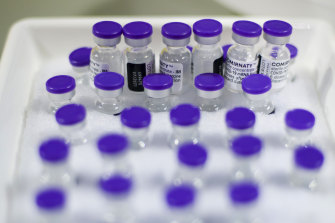New York: The Biden administration has put Johnson & Johnson in charge of a Baltimore manufacturing plant that ruined 15 million doses of its COVID-19 vaccine, and moved to stop the facility from making another vaccine developed by AstraZeneca.
The extraordinary move by the federal Department of Health and Human Services will leave the Emergent BioSolutions facility solely devoted to making the Johnson & Johnson single-dose vaccine and is meant to avoid future mix-ups, according to two senior federal health officials. Johnson & Johnson confirmed the changes, saying it was “assuming full responsibility” for the vaccine made by Emergent.
The extraordinary measure was taken after a mistake at the Baltimore plant caused millions of vaccine doses to be spoiled.Credit:Bloomberg
The change came in response to the recent disclosure that Emergent, a manufacturing partner to both AstraZeneca and Johnson & Johnson, accidentally mixed up the ingredients from the two different vaccines, which forced regulators to delay authorisation of the plant’s production lines.
Federal officials are worried that the mix-up will erode public confidence in the vaccines, just as President Joe Biden is making an aggressive push to have enough vaccine doses to cover every American adult by the end of May. At the same time, there is deep concern about the safety of the AstraZeneca vaccine, amid a health scare that has prompted some European countries to restrict its use.
AstraZeneca said in a statement that it would work with the Biden administration to find an alternative site.
The ingredient mix-up, and Saturday’s move by the administration, is a significant setback and public relations debacle for Emergent, a Maryland biotech company that has built a profitable business by teaming up with the federal government, primarily by selling its anthrax vaccines to the Strategic National Stockpile.
A spokesperson for Emergent declined to comment, except to say that it would continue making AstraZeneca doses until it receives a contract modification from the federal government.
Experts in vaccine manufacturing said that in the past, the FDA had a rule to prevent such mishaps by not allowing a facility to make two live viral vector vaccines, because of the potential for mix-ups and contamination.
The reorganisation of the Baltimore plant is another setback for AstraZeneca, which unlike Johnson & Johnson does not yet have emergency authorisation from the Food and Drug Administration for its vaccine. With three federally authorised vaccines (the other two are by Pfizer-BioNTech and Moderna) it is not clear whether the AstraZeneca vaccine, which has had a troubled history with regulators, could even be cleared in time to meet US needs.
However, one of the federal officials said the Health and Human Services Department was discussing working with AstraZeneca to adapt its vaccine to combat new coronavirus variants.
None of the Johnson & Johnson doses made by Emergent have been released by the FDA for distribution. The agency’s acting commissioner, Dr Janet Woodcock, said in a statement that the agency “takes its responsibility for helping to ensure the quality of manufacturing of vaccines and other medical products for use during this pandemic very seriously.”
But she made clear that the ultimate responsibility rested with Johnson & Johnson. “It is important to note that even when companies use contract manufacturing organisations, it is ultimately the responsibility of the company that holds the emergency use authorisation to ensure that the quality standards of the FDA are met.”
Emergent’s Baltimore facility is one of two facilities that were built with taxpayer support and are federally-designated as “Centres for Innovation in Advanced Development and Manufacturing.” Last June, the government paid Emergent $US628 million to reserve space there as part of Operation Warp Speed, the Trump administration’s fast-track initiative to develop coronavirus vaccines.
Johnson & Johnson and AstraZeneca both contracted with Emergent to use the space. Both vaccines are so-called live viral-vector vaccines, meaning they use a modified, harmless version of a different virus as a vector, or carrier, to deliver instructions to the body’s immune system. The Johnson & Johnson vaccine is one dose; AstraZeneca’s vaccine is two doses.
Last month, Biden cancelled a visit to the Emergent Baltimore plant, and his spokesperson announced that the administration would conduct an audit of the Strategic National Stockpile, the nation’s emergency medical reserve. Both actions came after a New York Times investigation into how the company gained outsize influence over the repository.
Meanwhile, for the first time, more than 3 million people, on average, are receiving a COVID-19 vaccine each day in the United States, according to data from the Centres for Disease Control and Prevention. And on Saturday the country reported over 4 million doses in a single day for the first time.
The milestones reflect a steady increase in the capacity of states to deliver shots into arms. In early March, the nation surpassed an average of 2 million doses administered each day. The average hovered at around 800,000 doses a day in mid-January. And nearly one-third of the US population has received at least one dose of a COVID-19 vaccine as more states expand eligibility and production ramps up.
The news, which comes as President Biden enters the home stretch of his first 100 days in office and amid the general declines in new virus cases, deaths and hospitalisations since January, offers a sign of hope for a weary nation. But the average number of new reported cases has risen 19 per cent over the past two weeks, and federal health officials say that complacency about the coronavirus could bring on another severe wave of infections.
The New York Times
Most Viewed in World
From our partners
Source: Read Full Article

